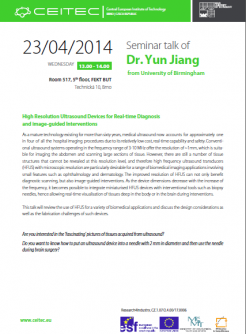Are you interested in the ‘fascinating’ pictures of tissues acquired from ultrasound?
Do you want to know how to put an ultrasound device into a needle with 2 mm in diameter and then use the needle during brain surgery?
Let´s come!
As a mature technology existing for more than sixty years, medical ultrasound now accounts for approximately one in four of all the hospital imaging procedures due to its relatively low cost, real-time capability and safety. Conventional ultrasound systems operating in the frequency range of 3-10 MHz offer the resolution of ~1mm, which is suitable for imaging the abdomen and scanning large sections of tissue. However, there are still a number of tissue structures that cannot be revealed at this resolution level, and therefore high frequency ultrasound transducers (HFUS) with microscopic resolution are particularly desirable for a range of biomedical imaging applications involving small features such as ophthalmology and dermatology. The improved resolution of HFUS can not only benefit diagnostic scanning, but also image-guided interventions. As the device dimensions decrease with the increase of the frequency, it becomes possible to integrate miniaturised HFUS devices with interventional tools such as biopsy needles, hence allowing real-time visualisation of tissues deep in the body or in the brain during interventions.
This talk will review the use of HFUS for a variety of biomedical applications and discuss the design considerations as well as the fabrication challenges of such devices.








